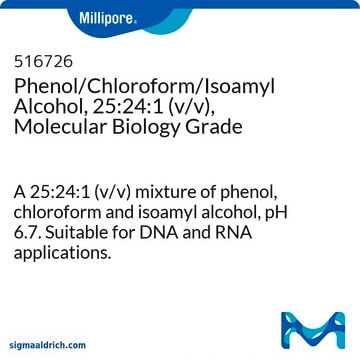P4682
Fenol
BioReagent, Saturated with 0.01 M citrate buffer, pH 4.3 ± 0.2, for molecular biology
Sinônimo(s):
nucleic acid extraction
About This Item
Produtos recomendados
grau
for molecular biology
linha de produto
BioReagent
forma
liquid
técnica(s)
RNA purification: suitable
pH
4.1-4.5 (25 °C)
temperatura de armazenamento
2-8°C
cadeia de caracteres SMILES
Oc1ccccc1
InChI
1S/C6H6O/c7-6-4-2-1-3-5-6/h1-5,7H
chave InChI
ISWSIDIOOBJBQZ-UHFFFAOYSA-N
Informações sobre genes
human ... GABRA1(2554)
Procurando produtos similares? Visita Guia de comparação de produtos
Descrição geral
Aplicação
- for the extraction of RNA by standard phenol-chloroform protocols
- in cell wall monosaccharide analysis to treat epidermal strips from the abaxial side of Commelina communisin leaves
- as a component of lysis-denaturation buffer for RNA isolation
Ações bioquímicas/fisiológicas
produto relacionado
Palavra indicadora
Danger
Frases de perigo
Declarações de precaução
Classificações de perigo
Acute Tox. 3 Dermal - Acute Tox. 3 Inhalation - Acute Tox. 3 Oral - Aquatic Chronic 2 - Eye Dam. 1 - Muta. 2 - Skin Corr. 1B - STOT RE 2
Órgãos-alvo
Nervous system,Kidney,Liver,Skin
Código de classe de armazenamento
6.1A - Combustible acute toxic Cat. 1 and 2 / very toxic hazardous materials
Classe de risco de água (WGK)
WGK 2
Ponto de fulgor (°F)
Not applicable
Ponto de fulgor (°C)
Not applicable
Certificados de análise (COA)
Busque Certificados de análise (COA) digitando o Número do Lote do produto. Os números de lote e remessa podem ser encontrados no rótulo de um produto após a palavra “Lot” ou “Batch”.
Já possui este produto?
Encontre a documentação dos produtos que você adquiriu recentemente na biblioteca de documentos.
Nossa equipe de cientistas tem experiência em todas as áreas de pesquisa, incluindo Life Sciences, ciência de materiais, síntese química, cromatografia, química analítica e muitas outras.
Entre em contato com a assistência técnica




